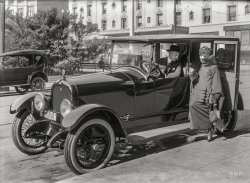
MAY CONTAIN NUTS

Search Shorpy
SHORPY ART

Framed or unframed, desk size to sofa size, printed by us in Arizona and Alabama since 2007. Explore now.
Join and Share
Ad-Free Shorpy
Shorpy is funded by you. Patreon contributors get an ad-free experience.
Learn more.

Recent comments
- Killed by Amtrak
- Back to the Future
- Heckuva remote control!
- Sometimes — Things Go Bump!
- I SEE THE LIGHT
- Union Switch and Signal Company
- Get That Light Out Of My Eyes
- Eggs. Eggs. Eggs. The Egg Man is Here!
- Foreboding caption
- Famous Hollywood faces
- Not just S&P
- re: Those things in the jar
- Up In Smoke
- Medical Smoking
- Quick fix
- A Quink Comment
- If You’re Like Me, Never
- Delivering the News
- U.S.A.
- S&P
- 1940 Zenith radio model 6G601
- Quality goes in before the name goes on!
- Snazzy skirt
- Carbon Arc Lamps
- Illuminate us
- I remember it well
- I can't prove it
- Complicated then, forgotten now
- Bryan-Stevenson
- Skinny is as skinny does
Member Photos
The Shorpy
Print Emporium
Print Emporium
Search Shorpy
Search results -- 30 results per page
- The Jazz Driver: 1927
- ... "Al Jolson and Cadillac touring car at St. Francis Hotel, San Francisco, 1927." The year he made talkie history in "The Jazz Singer." 5x7 ... Posted by Dave - 11/11/2015 - 10:04am -
![The Jazz Driver: 1927 "Al Jolson and Cadillac touring car at St. Francis Hotel, San Francisco, 1927." The year he made talkie history in "The Jazz Singer." 5x7 glassneg. View full size.
Socks, pro and conThe plus-fours look pretty silly.
On the other hand, I'd like to see socks make a comeback in baseball. They would be a big improvement over the current pajama-bottom pants, long enough for a player to trip on.
Such clarityAnother courageous Shorpy posting of a vehicle without blurred/pixelated license plates! I'd personally love to see one of these San Francisco classics to cross the bridge to Oakland for an accident staged by Harry Whittier Frees.
Plus-Fours!Something that should never *ever* come back in fashion.
Big in PicturesI never really thought about how tall Al Jolson was. While the cars were probably higher than ours today, I'd still say he's not basketball player material.
No disrespect intended, from 78's and film it seems he exuded so much vitality he was the biggest thing wherever he appeared. His public persona was not a self-doubting one.
Swanee ShoesThose shoes Al is wearing looks like something freshly re-purposed from the Swanee River.
Not just big in picturesAl came from the projection era, not the microphone era.
He had to project to the back of the room when he was on stage.
I've read that he was quite the character on and off the stage. He also entertained for the troops quite often.
I think he was a hit with the ladies, too-his fourth and final wife was considerably younger than him, and quite the looker.
From Vaudeville to burlesque, Al did it all.
Not the Dreaded Golf?The other chap's plus fours and Jolson's rather louche attire (for a city as self-consciously formal as San Francisco used to fancy itself) suggest that the insidiously seductive pastime has either recently taken place or is soon to do so.
Odd twist of fateMr. Jolson died at this very hotel 23 years later, uttering these prescient final words "Boys, I'm going!"
Hood OrnamentThat hood ornament is a riot. Never seen one on any car from that era (or any other for that matter).
I wonder if that was specially made for Al?
[Thanks everyone. That's why I love Shorpy, because you learn so much about things you never knew]
Trumpeter hood ornamentI shared Baxado's impression of the hood ornament, but apparently Cadillac used this symbol during this period. It's a great design.
[Indeed. -tterrace]
Part # H-125That hood ornament is "The Cadillac Herald" (also known as the "Trumpet Tooter"), designed in 1926 by the sculptor Edward Everett Burr. It was available as an aftermarket item through a Canadian accessory house. In 1929 it became an official Cadillac part when the division put it in its accessory catalog - leading many to believe that it stood for heralding in the new 1929 models.
Jewelry designer Hans Brassler made a display version that featured real gems in the Cadillac crest on the herald's tunic. The original ornament was nickel-plated and a chrome reproduction was made in the 1970s (the reproduction is seen in the previous post).
Today the image is recreated in pewter by the Cadillac & LaSalle Club in the form of an award given to a person or group that has "promoted or generated conspicuous recognition for the Cadillac marque or important activities of the Cadillac & LaSalle Club."
(The Gallery, Cars, Trucks, Buses, Movies, San Francisco, W. Stanley)](https://www.shorpy.com/files/images/SHORPY-758.thumbnail.jpg)
- Survivor for Now: 1940
- San Francisco 1940. "Silas Palmer House, NW corner Van Ness and Washington. ... View full size.
Flaunters flouting, redux It's San Francisco and I see a lot of uncurbed wheels. Maybe they didn't have that ... Posted by tterrace - 05/19/2015 - 10:16am -
![Survivor for Now: 1940 San Francisco 1940. "Silas Palmer House, NW corner Van Ness and Washington. Essentially stick in style, with features of the Villa and Shingle eras, as well as tall Mansard roof on tower. Squared bays are typical of 1880s. Some pseudo-Moorish details on entrance porch. Cast iron cresting on roof. Built circa 1886. Destroyed after 1940" (from HABS notes dated 1961). Large format negative for the Historic American Buildings Survey, photographer unknown. View full size.
Flaunters flouting, reduxIt's San Francisco and I see a lot of uncurbed wheels. Maybe they didn't have that law in 1940, but they did when I was there in '65.
Silas's Bed And BreakfastOl' Silas's place would have made a great Bed And Breakfast while your Dodge was in the garage for a few days.
That dark DodgeThis is a picture of my 1939 Dodge D11. It is completely original paint, upholstery etc. I bought it from the original owner in 1970. A most excellent original automobile and very reliable with 75,000 miles on it. No, I do not drive it in winter.
Flaunting the LawHow many laws are being violated in this photo? I see at least three violations. One car parked on a corner, right in front of a fire hydrant. At least two vehicles parked on the sidewalk. I would mention the woman standing in the street, but I'll bet it was legal to stand in the roadway waiting to board a cable car.
[Right, she's not flouting the law, she's waiting in a streetcar "safety zone" marked off by the large metal buttons mounted in the pavement. -tterrace]
Ah! I see the error of my grammar! Thanks for setting me straight!
Nice Queen Anne style mansion from early in the American Queen Anne heyday...then of course I started looking at the cars, and thought, "Whoa, what's with all the Dodges & Plymouths?" THEN I saw the little sign in the far left: DGE/MOUTH.
THAT explained it.
Wow!I can only imagine the interior details; VERY high ceilings, magnificent staircase, servant/maid quarters in the basement w/access to the kitchen by a narrow twisting back staircase,--and one tiny, dark, stinky "water closet" added to the back of the building in the 1890s.
The view today[Note that Google wants to call Van Ness Avenue "El Camino Real," which has a historical association but is not the name of the street. -tterrace]
Contemporary of W. A. BechtelSilas H. Palmer established a contracting and engineering company (Palmer, McBryde, and Quayle) and eventually associated with Warren Bechtel in 1929. The latter founded what is now the largest construction and engineering firm in the USA (by starting with a mule team grading railroad beds in 1896)
Twisty back staircaseI bet you're right about the twisty back staircase but I would think the house came with a water closet (San Francisco being a big city, it probably had running water by this time) and, if I can go by other houses of this period, the toilet was in one room by itself, while the bathtub and sink were in another. Also, I'd guess the servants' rooms were on the third floor, possibly along with the nursery. At any rate, this is pretty much my dream home, outdated plumbing and all.
Our 1939 DeSotoChrysler Fan's pic of his 1939 Dodge prompted me to take apart one of our framed family pic montages to retrieve the attached. That is our 1939 DeSoto, with me at about age 4 or 5 on the left fender, and my brother, age 2 or 3 on the right fender. My dad bought it somewhat "used" from a better off brother-in-law.
My dream homeBut a painter's nightmare.
Question for San FranciscansCurious to know how many pre-1906 houses and/or buildings are still standing in present-day SF?
[Around 18,500 pre-1906 structures survive, most of them outside the burned area; Van Ness Ave. was a major fire line. More than 13,000 Victorians still stand. -tterrace]
(Cars, Trucks, Buses, HABS, San Francisco)](https://www.shorpy.com/files/images/016776pu.thumbnail.jpg)
- Camera Craft: 1938
- April 1, 1938. San Francisco. "Camera Craft store, 425 Bush Street. Mr. E.R. Young." 8x10 inch ... Champlin, published by Camera Craft Publishing Company in San Francisco in 1937. A September 1981 article in Popular Photography ... Posted by Dave - 04/07/2017 - 9:06am -
![Camera Craft: 1938 April 1, 1938. San Francisco. "Camera Craft store, 425 Bush Street. Mr. E.R. Young." 8x10 inch acetate negative by Moulin Studios. View full size.
Elementary PhotographyThoroughly Stimulating, Expertly Written. For the Student, the Club Member, and the Amateur Photographer. By C.B. Neblette, Frederick W. Brehm, and Everett L. Priest (Macmillan, 1936). Under glass on the left, and in the middle bookshelf on the right, under the heading Latest Photographic Publications.
A professional and hobbyist dreamThis must be the most exciting camera store I have seen. So many periodicals. Looks like a hobby I would totally take up. Photography today means a smartphone app and a YouTube "how-to" video. Not nearly as interesting at all.
Looks familiarThis looks pretty much identical to any of the many Embarcadero photo stores I recall seeing during my visits there. But no doubt lacking the ridiculous markups and high-pressure salesmen of the more recent establishments.
Champlin On Fine GrainBy Harry Champlin, published by Camera Craft Publishing Company in San Francisco in 1937. A September 1981 article in Popular Photography noted that Champlin “took a dim view” of the future of 35mm film since it was too small for “the exacting demands of commercial photography and newspaper work.” He predicted 70mm as the new standard.
A Dearth of CamerasFor a camera store I certainly don't see many.
[Camera Craft was a publishing company. -Dave]
Brand NewThat looks like my Solar brand enlarger head behind the Popular Photography mag.
Camera stores!Isn't it odd that the photo hobby has changed so much? In my area, I would visit Penn Camera, Ritz Camera, and Industrial Photo every week. Didn't need anything. Just hanging out with my friends who worked there and messing around.
Days gone by. I used to love hanging around typewriter and watch repair shops, too. Chatting with folks with specialized, exact knowledge and geeking out.
Those days were such fun.
Where's the 'Phone?It's at the rear of the store, attached to a set of shelves. It appears to be a Western Electric Model 211 Spacesaver, and in this store that really is a plus.
When I was 12 my father gave me an Australian Kodak contact print set to make my own photos. It included a safe light, developing tank, trays, paper and chemicals to learn photo processing and printing. I later belonged to a camera club at school, and as an adult acquired an enlarger. I made my own prints in B&W for many years, but never graduated to colour. The enlarger resides in my attic since I went digital. I can now scan my old B&W negatives, and process them on my computer without all the liquids, fumes, etc. But I do miss the experience of visiting the camera store to stock up on supplies.
Camera Craft Still being published. Or rather being published again.
http://cameracraft.online/
Clamp lightsStill unchanged after almost 80 years!
Popular Photography 1937-2017Camera Craft may still be publishing but Popular Photography (bottom of the magazine rack) just shut down.
The Kodak LetterCurious about the "Kodak Letter" poster partly seen on the upper right, I found it was a 1918 magazine ad encouraging people to send photos to their soldiers "over there" in WWI. So it was already a vintage poster (and camera) in 1938.
[Good work. I was wondering about that thing that looks like an antique cable modem! - Dave]
Camera in "The Kodak Letter" adThe camera in the "Kodak Letter" poster from 1918 probably is
this one. It does look a bit like a cable modem when folded! I recall my granddad (who was just a bit too young for WW I) had something like this when I was small. It was fascinating.
[However, many Kodak folding cameras of the period looked like this when closed. -tterrace]
Interesting location.The location of this business would later become the location of KFRC, the legendary San Francisco radio station of the 60's and 70's.
(The Gallery, San Francisco, Stores & Markets)](https://www.shorpy.com/files/images/SHORPY-1124.thumbnail.jpg)
- Market Street: 1947
- "San Francisco 1947" is the notation on this latest Kodachrome from Don Cox. Who, ...
UPDATE: After doing a little more research, I see that San Francisco operates a number of vintage streetcars that utilize these ... Posted by Dave - 02/26/2021 - 11:53am -
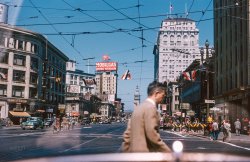
- Up From the Ashes: 1906
- San Francisco rebuilds after the devastating earthquake and fire of April 18, 1906. ... inch glass negative from Wyland Stanley Collection of San Francisco historical memorabilia later acquired by Marilyn Blaisdell. ... Posted by Dave - 10/17/2014 - 8:58am -
![Up From the Ashes: 1906 San Francisco rebuilds after the devastating earthquake and fire of April 18, 1906. 8½x6½ inch glass negative from Wyland Stanley Collection of San Francisco historical memorabilia later acquired by Marilyn Blaisdell. View full size.
West of Nob HillHistry2 is right. The photograph looks from the west slope of Nob Hill toward the west. At least one distinctive building still stands in the 1700 block of Franklin, one block east and one-half block south of the park, that is, on the street that runs left to right one block before the park, and a half-block to the left of the left boundary of the park. It looks like a slice of a larger mansion, with one big window on its "first" floor and two dormers in its roof. A half-block further south, at Franklin and California, the house with the turret is also still standing.
Hyde and seekNot too many landmarks survive today, making this photo a bit of a challenge to locate.
However, if I've got my bearings correct, the hilltop park at upper right is today's Lafayette Park. By counting the cross streets, the intersection in the foreground is the junction of Hyde Street (running left to right) and Clay Street (heading towards Lafayette Park).
BTW, hats-off to San Francisco historian Marilyn Blaisdell for helping preserve this magnificent photo collection, along with many, many others.
[It's Shorpy who's doing the preserving now -- he bought this glass negative for $82 on eBay. And paid $868 for the scanner that imaged it. So we hope you're getting your money's worth!- Dave]
Good going Shorpy! Keep up the great work.
Not much left, but,The "White House" building is the current site (or next to) the Whole Foods at California & Franklin. At least four of houses visible on the opposite side of that interection still stand, including the landmark Wormser-Coleman House at 1834 California.
(The Gallery, Fires, Floods etc., San Francisco, W. Stanley)](https://www.shorpy.com/files/images/SHORPY-GN-009.thumbnail.jpg)
- You Are Here: 1922
- ... of the Jewett tells the tale.
Belvedere Island. San Francisco Yacht club in background.
Tiburon-Belvedere Photo was taken ... Posted by Dave - 08/13/2016 - 5:34pm -
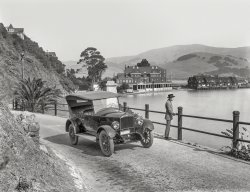
- To the Rescue: 1925
- San Francisco circa 1925. "California State Automobile Association -- Emergency ... has a brake of any kind. If these things were used in San Francisco, must have made for an adventurous day.
A lot of weight ... Posted by Dave - 07/07/2015 - 6:14pm -
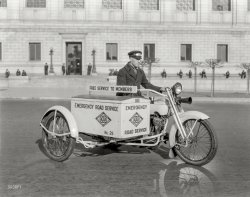
- Shiny Stockings: 1928
- San Francisco, 1928. "Graham-Paige at Golden Gate Park." Especially well equipped ... acted on the end of the spring. Not to be prurient but the San Francisco ladies certainly have upgraded suspensions too. Probably from ... Posted by Dave - 03/04/2016 - 1:39pm -
![Shiny Stockings: 1928 San Francisco, 1928. "Graham-Paige at Golden Gate Park." Especially well equipped with fender-mounted spares. 5x7 glass negative. View full size.
Air suspensionThere are what look to be small tanks under the fenders inboard each wheel. I think they must be shock absorbers that act on the center of the spring. A few days ago there was a picture of a car with Gruss shock absorbers which acted on the end of the spring. Not to be prurient but the San Francisco ladies certainly have upgraded suspensions too. Probably from walking up and down all those hills.
Dealer plateEvidently using sex to sell cars goes way back.
[And vice versa. - Dave]
Let's take them to the speakeasy to find outOK they look great sitting on the fenders - but can they dance a hot Charleston? That's what the darbs want to know.
Girls and GuysCan't decide if the girl on the right looks more like Tony Curtis or Jack Lemmon in Some Like It Hot.
Elementary --The shocks are Watson Stabilators.
(The Gallery, Cars, Trucks, Buses, Chris Helin, Pretty Girls, San Francisco)](https://www.shorpy.com/files/images/SHORPY-916.thumbnail.jpg)
- Model Tea: 1918
- San Francisco, 1918. "Buick at Japanese Tea Garden, Golden Gate Park." The styling: ... garden, soon became quite popular and were picked up by San Francisco Chinese restaurants. The rest is American culinary history.
... Posted by Dave - 06/01/2015 - 12:48pm -
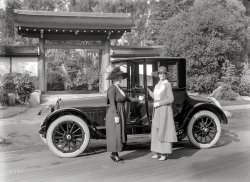
- The Palace: 1920
- "Market Street, San Francisco, 1920." Starring the Palace Hotel and, rising behind, the Call ... are actually historic landmarks, specifically "San Francisco Landmark #200 Path of Gold Light Standards." They're part of the ... Posted by Dave - 05/03/2016 - 1:05pm -
![The Palace: 1920 "Market Street, San Francisco, 1920." Starring the Palace Hotel and, rising behind, the Call Building. 8x10 glass negative. photographer unknown. View full size.
What is writtenon the sidewalk at the bottom right.
[CROCKER SAFE DEPOSIT VAULTS. Camouflaged as manholes. - Dave]
What's up?Those are the tallest street lights/lamps I have ever seen. Can't imagine the purpose of putting them that high up, and maintenance must have been fun.
[They're still in use on Market Street, including at this very corner. -tterrace]
Street Lights.The reason the street lights are so high is they served dual purpose. If you look closely you can see where the catenary (trolley wire) is actually attached to them. This actually wasn't all that uncommon at one time, since it allowed the city to have its public transit system, and to hide the (usually) unsightly support poles. What's more, it also meant that you didn't have to clutter things up with a second set of poles for the lights themselves.
Gorgeous Inside and Out!My husband and I were able to enjoy this grande dame hotel on a recent visit, and the interior spaces are as beautiful the streetscape. The Garden Court is an amazing space, I only wish we'd been there during the day to see the stained glass skylights.
"The Roar of the Four"The title is in reference to the constant stream of streetcars during the era of competition between the Municipal Railway and the Market Street Railway. Today the Muni has two surface tracks as well as two subterranean tracks at this location. Below them BART has its too tracks. Roar of the Six?
Let There Be LightsThose extra-tall streetlights are actually historic landmarks, specifically "San Francisco Landmark #200 Path of Gold Light Standards." They're part of the City Beautiful movement of the early 1900s, meant to illuminate San Francisco's then-primary artery Market Street.
Initially installed in 1916, the poles' bases were designed by famed West Coast architect WIllis Polk and feature bas relief images of covered wagons, mountain lions, and alternating prospectors and Native Americans.
For more info on Path of Gold check out this page.
(The Gallery, Cars, Trucks, Buses, San Francisco, Streetcars)](https://www.shorpy.com/files/images/SHORPY-963.thumbnail.jpg)
- Grading on a Curve: 1922
- San Francisco, 1922. "Cliff House road construction, view of Sutro Heights and ... being sold by W. J. Benson Co. located at 1420 Van Ness, San Francisco in 1922. Benson sold the Stephens marque circa 1919 - 1923, but ... Posted by Dave - 02/24/2016 - 6:00pm -
![Grading on a Curve: 1922 San Francisco, 1922. "Cliff House road construction, view of Sutro Heights and Playland amusement park." 6x8 inch glass negative. View full size.
My vote's with HayslipThe radiator shell is a match for the Stephens, and the logo is the right shape. The only thing that doesn't match is the hubcaps.
Dave, can you please give us a closeup of the logo on the radiator shell? This one had me stumped, until Hayslip posted. Not a lot of pictures of Stephens on the Web.
[The car is indeed a Stephens. - Dave]
Car ID suggestion1922 Stephens Salient Six-93
A DuesieThe car is a 1922 Duesenberg. I have the book by Don Butler on Auburn Cord Duesenberg with the perfect match. The two brothers Fred and Augie are on the radiator emblem but can't be seen well on your photo.
[The car here is most definitely not a Duesenberg. - Dave]
True Steam ShovelThe ancient construction equipment in this photo would warm the heart of any old truck enthusiast.
The excavator in the foreground is a true steam shovel complete with steam escaping from the safety valve. Other than museums, I have not seen one of those at work since the 1960's, and they were obsolescent even then.
In the background, there's another steam-powered crane. We can't see what it's doing; likely working a clamshell bucket or a dragline bucket.
The truck in front of the far crane seems to have a canopy on the back, possibly sheltering an air compressor. (The hoses strewn about the site are presumably air hoses.)
Construction's finishedThis is the current view looking southeast along Point Lobos Avenue from the Cliff House.
The sprawling amusement park visible in the 1922 photograph (which eventually became "Playland at the Beach") was demolished in 1972 and replaced in the 1980s by the dreadful condominiums visible today.
Watch it now!If you go to Kinzers in PA, you can watch these earth-moving mechanical masterpieces working hard, still today. Beautiful machines!
Dealer 27The automobile dealer number on the license plate (27) indicates that the car was being sold by W. J. Benson Co. located at 1420 Van Ness, San Francisco in 1922. Benson sold the Stephens marque circa 1919 - 1923, but he was in automobile business in San Francisco both before and after these years.
Erie Type AJust a guess on the shovel, Erie Type A?
Here's one in action, looks like a handful to operate.
https://www.youtube.com/watch?v=oJEin7oVajQ
(The Gallery, Cars, Trucks, Buses, San Francisco, W. Stanley)](https://www.shorpy.com/files/images/SHORPY-906A.thumbnail.jpg)
- Family Truck: 1923
- San Francisco circa 1923. "Fageol motor truck -- G.W. Thomas Drayage & ... Safes, Vaults, Smokestacks, Boilers. 77 Stevenson Street, San Francisco, Cal., Telephone Kearny 3298.
[Also seen here . - ... Posted by Dave - 08/08/2015 - 4:16pm -
![Family Truck: 1923 San Francisco circa 1923. "Fageol motor truck -- G.W. Thomas Drayage & Rigging." And their little dog, too, along with a liberal sprinkling of totlets. 6½ x 8½ glass negative, originally from the Wyland Stanley collection. View full size.
Bartfeld Sales Co.140-150 14th Street.
Our GangWith Spanky and Alfalfa, peering out of the window, wishing that they could tag along.
Fasten your seat belts.Hard rubber tires, brick road, it's going to be a bumpy ride!
Looks like a swayback mulewith googly eyes and short legs.
Safe MoversAdvertisement in the Official Year Book of the California State Federation of Labor, 1916.
G.W. Thomas Drayage & Rigging Co.
General Draying, Safe and Machinery Moving
Special Attention Given to Rigging, Hoisting and Placing Heavy Machinery, Safes, Vaults, Smokestacks, Boilers. 77 Stevenson Street, San Francisco, Cal., Telephone Kearny 3298.
[Also seen here. - Dave]
(The Gallery, Cars, Trucks, Buses, Dogs, Kids, San Francisco, W. Stanley)](https://www.shorpy.com/files/images/SHORPY-488-01A.thumbnail.jpg)
- Paiges on Parade: 1926
- "Paiges on Fillmore Hill at Broadway." San Francisco in 1926 is the setting for this latest entry in the Shorpy Pageant of ... of Fillmore Street is so steep that, for many years, San Francisco's Market Street Railway employed counterbalance cars on its #22 ... Posted by Dave - 11/20/2014 - 4:44pm -
![Paiges on Parade: 1926 "Paiges on Fillmore Hill at Broadway." San Francisco in 1926 is the setting for this latest entry in the Shorpy Pageant of Extinct Conveyances, a passel of parked Paiges. 8x10 film negative by Christopher Helin. View full size.
Counterbalanced Street CarsThis stretch of Fillmore Street is so steep that, for many years, San Francisco's Market Street Railway employed counterbalance cars on its #22 line. These streetcars operated as normal electric cars for most of the line, but when they hit the Fillmore grade they hooked onto underground cables to help them up the hill.
But these weren't cable cars. Instead of a powered cables, like on the City's cable car lines, the counterbalance system required another car at the opposite end of the line to be simultaneously hooked onto the cable. Simply put, as one car descended the hill it helped another car ascend.
More info on the Fillmore Counterbalance here.
Traction for Horsepower?The Paiges drivers semm to have inconsiderately parked their vehicles fouling the cable car line.
But, I want to know what Shorpyists think is the purpose of the cleated roadway to the right of their vehicles.
[It's a sidewalk, a sort of road for pedestrians. The ribs are so you don't slip. On the other side of the street we have stairs. And overhead, power for the streetcars. -Dave]
Broadway at FillmoreExcept for the one peeking out from the left edge, all these buildings on Broadway are still there. The leftmost has had another floor added. The largest, 2275 Broadway, was built that year.
View Larger Map
Cable or Trolley?Here's a link to a description of the Fillmore St. counterbalance for electric trolley cars. The modern photo shows that the replacement trackless trolleys (trolley buses) detour around the hill.
88 years later: Then and NowI had to do some heavy perspective manipulation on this one, along with compositing another view to get the street somewhat in sync. The compositing is a bit crude, but I just wanted to give the impression of the street. I think it's reasonably effective, considering I can't get the same perspective from the other sidewalk that the original photographer got. (Google Streetview / September 2014.)
Click here for large size
Fillmore GripWasn't this the nickname for some sort of cable haulage for electric cars over a section of track that was too steep for normal traction?
Re: TractionJust a minor nitpick, but thne streetcars in San Francisco use underground cables for the motive power, not overhead lines. The cars clasp the underground cables and are towed up the hills and kept from speeding too fast back down.
The overhead lines are most likely power lines for homes and businesses.
[Wrong. See the next comment up. - Dave]
Time machine?Hey, why is there a closed circuit camera above the car second from the left! Time traveler shenanigans!
(The Gallery, Cars, Trucks, Buses, Chris Helin, San Francisco)](https://www.shorpy.com/files/images/SHORPY-134-02.thumbnail.jpg)
- Automobile Row: 1918
- San Francisco circa 1918. "Chalmers Model 6-30 roadster facing N.W. corner Van Ness ... The fire hydrant at right was manufactured by the local San Francisco foundry M. Greenberg & Sons. First installed in SF in the ... Posted by Dave - 05/14/2016 - 12:52pm -
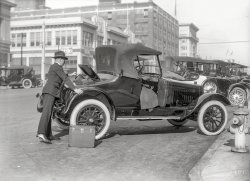
- Shaken & Singed: 1906
- "Ruins of Pettibone Bros., New Montgomery Street." San Francisco in the aftermath of the earthquake and fire of April 18, 1906. 8x10 ... Posted by Dave - 05/24/2022 - 2:37pm -
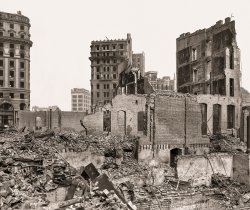
- The Palace: 1906
- "Palace Hotel, New Montgomery Street." San Francisco in the aftermath of the earthquake and fire of April 18, 1906. 8x10 ... . Not only are they possibly the earliest color photos of San Francisco, they're also 3-D.
(The Gallery, DPC, Fires, Floods etc., San ... Posted by Dave - 08/21/2012 - 10:52am -
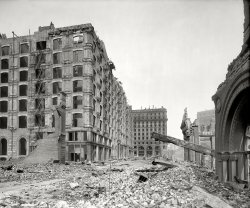
- Private Coach: 1931
- San Francisco circa 1931. "Pierce-Arrow limousine." Latest entry in the Shorpy File ... tires decades before it became a fad in the 1960s.
San Francisco City employees could get the same discount as the City Purchasing ... Posted by Dave - 05/24/2017 - 12:59pm -
![Private Coach: 1931 San Francisco circa 1931. "Pierce-Arrow limousine." Latest entry in the Shorpy File of Funereally Funky Phaetons. 5x7 glass negative by Chris Helin. View full size.
Are you sure?A Pierce Arrow without the bigeye headlamps? I'm no expert but that's the first thing I noticed. Also those not period correct 1" whitewall tires.
[You're right about one thing. - Dave]
Service carIf you look on the back of the car, you will see what looks like a door handle and no trunk rack. This leads me to think that this is some type of service car, along the lines of a private ambulance.
Perchance an AmbulanceThe 1924 Pierce Arrow Model 33 Ambulance depicted here
https://en.wheelsage.org/pierce-arrow/model_33/79830/pictures/z35bjq/
appears to be a predecessor.
Barrett's your visionary tire manNot only did the Akron based India Tire Company manufacture skinny whitewalls in the 1930s, in the late 1920s they offered red striped tires decades before it became a fad in the 1960s.
San Francisco City employees could get the same discount as the City Purchasing Agent did—this from the March 1932 edition of the "San Francisco Municipal Record"
Born 1926 or EarlierThe hood, wheels, and fenders expose this vehicles origins as a 1921 to early 1926 Pierce-Arrow Series 33. The grouping of the hood louvers in the pattern shown was not used on any other model or during any other model years. By 1931 the hub caps covered the lug nuts as well as the axle ends, and the side mounted spare tires were placed much deeper into the front fenders.
Possibly this vehicle was converted to the body style shown here at the time of the photo. When produced without the headlights built into the fenders, most Pierce Arrows of the early 1920s came from the factory with drum style headlights as shown in the photo below of a 1923 Pierce-Arrow Model 33 limousine. A 1924 ambulance and a 1931 Pierce-Arrow funeral coach bodied by Eureka are also shown.
(The Gallery, Cars, Trucks, Buses, Chris Helin, San Francisco)](https://www.shorpy.com/files/images/SHORPY-1171.thumbnail.jpg)
- Hudsons Bay: 1919
- San Francisco, 1919. "Hudson autos at Land's End." Conveyances for at least four ... cars were registered to Arthur E. Maumus of 860 Geary in San Francisco. Arthur was a jewelry salesman. The two people pictured are ... Posted by Dave - 04/06/2016 - 7:41pm -
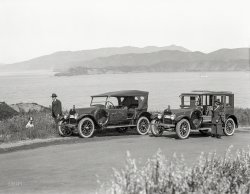
- Vacancy: 1906
- 1906. "Fairmont Hotel, San Francisco, amid ruins of earthquake and fire." The hotel, near completion when ... My jaw dropped! I take the #1 California bus in San Francisco several times a week, which drives right by the Fairmont. Wow. ... Posted by Dave - 07/30/2012 - 4:32pm -
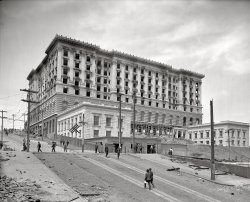
- New Moon: 1920
- San Francisco circa 1920, back at 2150 Washington St. "Moon auto." And if you ... Looks like some of the granite curbs that can be found in San Francisco.
Quite a shine on that finish! Such clear reflections.
... Posted by Dave - 04/13/2016 - 11:33am -
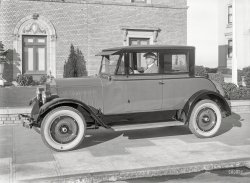
- Vroom With a View: 1928
- San Francisco circa 1928. "DeSoto sedan cresting hill." Last seen here a year ... Steve McQueen's father.
Scary driving I flew into San Francisco once for a convention and after a few days rented a car to drive ... Posted by Dave - 02/09/2016 - 5:42pm -
![Vroom With a View: 1928 San Francisco circa 1928. "DeSoto sedan cresting hill." Last seen here a year ago, making steady progress up Webster Street toward points unknown. 5x7 inch glass negative by automotive impresario Christopher Helin. View full size.
Bullitt: the PrequelI presume it's being chased by a 1928 Ford, driven by Steve McQueen's father.
Scary drivingI flew into San Francisco once for a convention and after a few days rented a car to drive up to Oregon. I picked the car up near this very street, and when I came out of the garage I was actually afraid I'd slide backward if I stopped. I'm sure you get used to it, but for a flatlander, the first time on those hills is a very scary experience.
Love the old car photosbut I can't help but wonder, how were the cars transported in the early days. Flatbed? Inside box cars? In your archives do you have any photos of the actual loading and unloading of the cars that make it to San Francisco where, apparently, all car makers wanted their new models photographed.
Re: Scary DrivingEven for Bay Area drivers, it can still be "exciting" at times! For extra fun, try navigating through SF hill streets with a manual transmission after the clutch throwout mechanism failed part way through the trip (my Datsun 510 in the early 70's). Shifting without the clutch is tricky, but learnable. Stopping at an intersection and starting out again is insane!
[My baptism of fire was in the 70s in a Datsun 1200 on Gough which, if you were brave and wanted to avoid congested Van Ness, you took to catch the Central Freeway to continue south on 101. You tried to time it to arrive first at the stop signs so you could pull up over the hump rather than being stuck on the incline. -tterrace]
Exactly, TT! And pre-280, that was the only reasonable way through the City, north- or south-bound. Starting the engine in gear made that placement a requirement...
(The Gallery, Cars, Trucks, Buses, Chris Helin, San Francisco)](https://www.shorpy.com/files/images/SHORPY-893.thumbnail.jpg)
- Beach Chic: 1957
- ... in October of 1958 we flew in a United Airlines DC-6B from San Francisco to Hawaii. We stayed at the Royal Hawaiian for several days, and my ... Posted by Dave - 02/27/2023 - 1:56pm -
![Beach Chic: 1957 Honolulu, 1957. "On the beach at Waikiki." 35mm Kodachrome slide by Toni Frissell for the Sports Illustrated assignment "Hawaii -- The Sporting Look." View full size.
She knows!How to wear a sarong. If it weren't a family publication, more would be showing!
I like the "paved" beach, keeps things clean.
O Hawai'i!
Royal Hawaiian Hotel in 1958When our family moved from Canada to Australia in October of 1958 we flew in a United Airlines DC-6B from San Francisco to Hawaii. We stayed at the Royal Hawaiian for several days, and my first impression was that there were no doors into the lobby. After living in an industrial city everything seemed very exotic. Since it was the 1950s, we dressed up for travel and dinner at the hotel. My father took this Kodachrome of Mum, myself at right with sister Heather and brother Rob.
It will be two more yearsbefore Hawaii becomes our 50th state. Beautiful beach, lovely sarong ... very, how you say in French ... Oh là là. I like your title, Dave ... but didn't you leave out the k?
Whose sari now?Sports Illustrated still had 7 years to refine their editorial approach before the first sarong swimsuit issue.
Longboards for loanout.Classic style and obviously the same color scheme for loaning out to the people willing to try that sport. Only a few years later would California surfing and surf culture explode in the early 1960s.
GET UP!! The lady to the right looks disgusted with her lazy husband.
[They're not related. - Dave]
(The Gallery, Kodachromes, Pretty Girls, Swimming, Toni Frissell)](https://www.shorpy.com/files/images/SHORPY-42924a.thumbnail.jpg)
- Smooth Sailing: 1936
- ... "Pontiac convertible at Spreckels Lake, Golden Gate Park, San Francisco." A model family's model boats. 8x10 acetate negative. View full ... Posted by Dave - 02/04/2015 - 2:03pm -
![Smooth Sailing: 1936 April 8, 1936. "Pontiac convertible at Spreckels Lake, Golden Gate Park, San Francisco." A model family's model boats. 8x10 acetate negative. View full size.
What a streamlined beauty!The Pontiac's nice, too!
BA-BOOM!
That NEVER gets old!
["At her best with the top down." Watch and learn, lads. - Dave]
7-Foot VoyageWhat did they do when the sailboats drifted beyond the reach of the bamboo? Nobody in this photo seems dressed for aquatic retrieval of wayward vessels.
Boat chasersThe lake is only 950 x 420 feet so they probably just ran around to the other side to get their wayward boats. Or maybe that nice lady will give them a ride. It is still home of the San Francisco Model Yacht Club.
Dress CodeHer ensemble seems better suited to leaning against a Cadillac ... or a LaSalle, anyway.
Contrasting contemporariesI doubt that Steinbeck was spending much time hanging out with these folks.
Two-seater?It must have been crowded when all four of them rode to the lake in that 2-seater cabriolet.
[This four-passenger Pontiac DeLuxe Cabriolet has a rumble seat. -Dave]
Weather GaugeLooks like the closest boat has what little wind there is (he's got the weather gauge) which means the others are trying to sail with nearly zip wind. In any case it doesn't look like there is much wind anyway.
(The Gallery, Boats & Bridges, Cars, Trucks, Buses, San Francisco)](https://www.shorpy.com/files/images/SHORPY-215-02A.thumbnail.jpg)
- Star Car: 1922
- San Francisco circa 1922. "Star auto ascending steep grade." With a shout-out to FS ... year.
Crossed legs . . . Must have been on one of San Francisco's steeper hills judging from the stance of the photographer ... Posted by Dave - 09/18/2014 - 2:03pm -
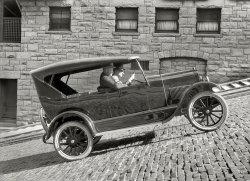
- Big Rigs: 1936
- August 15, 1936. "Sterling trucks in San Francisco." With a chain drive that looks like something off a giant bicycle. ... Stadium" at the corner of 16th and Bryant Streets in San Francisco. Now THAT was a ballpark!
Built in 1931, Seals Stadium was ... Posted by Dave - 02/19/2015 - 11:44am -
![Big Rigs: 1936 August 15, 1936. "Sterling trucks in San Francisco." With a chain drive that looks like something off a giant bicycle. 8x10 inch acetate negative. View full size.
Seals StadiumAs the proud owner of an Oakland Oaks replica warmup jacket, all I can say is "booooo" :-)
Seriously, it was a great rivalry, and the inspiration for some terrific cartoons by Lee Sussman in the Oakland Tribune. I loved them as a kid. They usually came in pairs on succeeding days, one setting up a confrontation before a game (usually against the Seals) and the next one after the game based on who one.
The Bay Area in the 1950s was the closest to paradise that I'll ever get.
Long lasting chainsMack didn't drop chain drive entirely until circa 1950. Knuckey finally quit making trucks in the mid-1950s and Cook lasted into the mid-1960s. Kenworth offered chain drive models at least into the late-1950s and possibly a little longer. As others have noted, they had a number of advantages, especially for heavy loads on soft surfaces or other places where high clearance was needed. These drives were very tough, by the way. I don't remember ever hearing a story about a chain breaking, though it must have happened; the repair would have been relatively easy in any case.
Grandma's TruckI remember my grandmother talking about driving a Sterling truck during the depression. She was able to get work one winter driving deliveries from a cheese factory in Beaver, Utah. She said the men were afraid to drive on the icy mountain roads, but she didn't know any better and was glad for the work.
After all these years, I remember the mention of Sterling trucks because I pictured them in my mind as gleaming silver, just like the silver in the display case we weren't allowed to touch.
Tires or TyresWhatever, they haven't changed much.
The chains they revereHot cha cha, more Sterlings. Love 'em. But who can explain why the chain drive? What advantage did it offer over a differential built into the rear axle? Doesn't seem any simpler to me, or more mechanically efficient, but then I am no engineer.
Chain functionperhaps the chain drives an accessory, such as a refrigeration compressor?
[The chain drives the wheels. - Dave]
The ChainsI believe, allowed the differential to be mounted solidly to the frame, which avoided universal joints in the driveshaft. There were chains on both sides, with independent drive to each. This allowed the axle to move up and down with the springing, and without the weight of the differential.
The boxWhat function does the box do on the floorboard? It has two hoses from it going forward.
Chain GangThe advantage to chain drive was that the gearing could be easily changed for different conditions. Hilly roads or heavy loads, just swap out the drive sprocket with a smaller one. Flat roads or light loads, go to a bigger one took no time at all.
Chains and BoxesChain drive had an advantage over rough or muddy ground; there was no axle and differential to get snagged. Note the chain oiling device; I'd be interested to see what the manual had to say about that ("stomp on the chain oiler pedal every 50 miles").
The box probably held the battery. They were high maintenance and needed easy access. The hoses are actually electrical cables.
Seals StadiumThat building in the left background looked suspiciously familiar. Turns out it's the late, deeply missed, "Seals Stadium" at the corner of 16th and Bryant Streets in San Francisco. Now THAT was a ballpark!
Built in 1931, Seals Stadium was home to the minor league San Francisco Seals until 1958 when the major league Giants moved from New York to San Francisco. The Giants played at Seals Stadium for the first two years in the city before moving to (shudder) Candlestick Park.
The Seals Stadium site is now a shopping mall.
Sterling RIP 2010Sterling was arguably the oldest brand-name truck in North America, having been in production off and on since the early 1900s to 2010. Originally produced under the name Sternberg, it was changed to Sterling in 1916 due to anti-German sentiment prior to WW1. The final version was basically a Ford Class 8 (heavy truck) design built by Daimler in St. Thomas, Ontario.
I remember Sterling trucks in my childhood; we could always hear an approaching Sterling because that chain drive gave them a unique sound.
(The Gallery, Cars, Trucks, Buses, San Francisco)](https://www.shorpy.com/files/images/SHORPY-255-01.thumbnail.jpg)
- Mr. Mister: 1939
- "Golden Gate International Exposition, San Francisco, 1939. International Harvester watering truck." The latest entry in ... the 20-acre plant propagation area created for the fair at San Francisco's Balboa Park. From the fair's site on Treasure Island in the ... Posted by Dave - 01/04/2015 - 4:35pm -
![Mr. Mister: 1939 "Golden Gate International Exposition, San Francisco, 1939. International Harvester watering truck." The latest entry in the Shorpy Catalogue of Discontinued Conveyances. 8x10 inch film negative. View full size.
Hoping for an AnswerHow long was it before vehicle manufacturers decided to install windshield wipers on both sides of the front windshields? Was it because they felt that only one wiper, on the driver's side, was necessary because it had to be operated manually by the driver, or is that not a correct assumption? Frankly, it is totally unsafe to have but a single wiper! Was it a matter of economy during the manufacturing process or were the vehicle engineers just totally oblivious to this safety hazard?
[I hestitate to guess how shocked you'll be to learn that there was a time when most cars had a total of zero wipers! -Dave]
GGIE locationThis was almost undoubtedly taken at the 20-acre plant propagation area created for the fair at San Francisco's Balboa Park. From the fair's site on Treasure Island in the middle of San Francisco Bay there'd be no view of nearby treeless hills like those in the photo.
WipersMy volunteer fire department's 1942 GMC has wipers on both sides but they each have their own on/off switch so the passenger was responsible for turning it on themselves if they wanted to see.
DIY WipersAs a kid I remember riding in cars that were so old that while they had two wipers, the one on the passenger side was manual. The driver's side had the old style vacuum wiper, which as the car accelerated would cause the wiper to slow down. I see this truck has a left side mirror, but none on the right side. When I learned to drive, our 1963 Falcon had no outside mirrors at all. In 1969, when I started my job as a trolley bus driver, Vancouver buses had no right side mirrors. Compare that to today's vehicles with rear view backup camera displays.
My '48 truckWas built with no options. One wiper, one sun visor, one (left) taillight, no heater, no outside mirrors. The turn signals work great, as long as you go to the trouble of cranking the window down so you can stick your arm out. The wiper switch is technically a valve, which connects the wiper mechanism to the intake manifold. As Angus J notes, you control wiper speed with the accelerator.
(The Gallery, Cars, Trucks, Buses, San Francisco)](https://www.shorpy.com/files/images/SHORPY-184-01.thumbnail.jpg)
- Gentlemen Will Not Get Gay: 1925
- ... does indeed remember a fun house ride like this, but at San Francisco's Playland at the Beach rather than Santa Cruz. Not sure what the ... Posted by Dave - 09/03/2012 - 11:56am -
![Gentlemen Will Not Get Gay: 1925 Funhouse at the Glen Echo amusement park in Maryland circa 1925. Note the many cryptic signs. View full size. National Photo Company glass negative.
Ride it, too!There is still one of these operating at Luna Park, which is right on the Harbour in Sydney, Australia. Leave it to the Australians to take litigiousness out of the equation--have you seen how little padding their footballers wear?
"The Nauseator"Boy, that ride looks truly thrilling.
Human RouletteWashington Post May 21, 1911
A New Glen Echo
Outdoor Amusement Grounds Present Many Attractive Features
With the opening next Saturday afternoon of the Glen Echo Park, which under its new management of local business men, has been practically rebuilt in the last few months, the Washington summer outdoor amusement season will swing into full stride.
No single department has been slighted in the complete rehabilitation of the Glen Echo Park, in which 50 attractions will be in operation when the gates are open next Saturday. Important among these is a new open air dancing pavilion, ample enough in area to permit of its use by 500 persons at the same time, and this is only one of a dozen structures recently erected to house the newest devices to provide fun and merriment in summer amusement parks. The spacious interior of the amphitheater has been entirely remodeled into a new midway, in which have been placed ten of the latest contraptions with which to defy the trials of the "dog days," including a "human roulette wheel" and a "giant slide-ride," said to be the largest in the United States. Other attractions include a novel marine toboggan, the "social dip," a thrilling topsy-turvy ride, Ferris wheel, modern miniature railway, a new boating pavilion at the canal bank.
Some Observations1. It is awfully loud in there - See the kid lower-center.
2. Gentlemen Still Do Not Get Gay - 2008.
3. The Carneys are as well dressed the patrons.
4. Sometimes the Bull Moose isn't so fun - It's at those times that it may be necessary to actually shoot the Bull.
Was this ride called the Bull Moose by chance? Don't Shoot The Bull meant don't loiter after the "ride" is over??
[Also, who can tell us which building this is. - Dave]
Dangerous ridesWhen I see photos of old amusement park rides I'm always amazed how dangerous they look. They use the throw people around like rag dolls. They would never have such rides nowadays. Maybe people were tougher back then- or maybe they didn't have good personal injury lawyers!
Sign, SignEverywhere a sign.
1. Sit down on the wheel don't stand up.
2. Do not get on or off roulette wheel while in motion.
3. Last night we hung one rowdy. The rope still works.
4. The operator is a bird. He is perched high just to make the wheels hum.
5. Forget your cares. Be a kid if only for an hour.
6. Gentlemen will not get gay. Others must not.
7. The bull moose is for fun. Don't shoot the bull.
8. If you find a four foot round square please hand it over to ru---.
9. Rowdyism is the birth-mark of a rough n---.
10. The answer to the question "Why is a mouse when it spins" is the higher the fewer.
Human roulette wheelNo doubt Dave will remember the "human roulette wheel" from the Fun House on the Boardwalk in Santa Cruz, CA. It was a great ride except for flying off and smashing into someone else or being smashed into. Funny but we all had a great time, survived, and didn't feel a need to sue anyone for a few bumps and bruises.
[I think you mean tterrace. - Dave]
High Ladder to slide....Look how high the children climbed to get onto the sliding spiral....that must have been half the thrill climbing up that high...
Getting GayBased on one OED definition of gay:
Forward, impertinent, too free in conduct, over-familiar; usually in the phrase "to get gay". U.S. slang.
I'd translate the sign from 1925 slang:
"Gentlemen will not get gay. Others must not"
Into current vernacular as:
"Real gentlemen won't act like jerks. Others had better not."
Spinningtterrace does indeed remember a fun house ride like this, but at San Francisco's Playland at the Beach rather than Santa Cruz. Not sure what the official name was; I called it the turntable. It was smaller and less elaborate than this, and just one of many things in the Fun House. Know what the best thing was about these things? They were made of wood! Highly-polished (in large part by the posteriors of the fun-seekers) hardwood, like this one. The giant slide was, too, as well as the tumbler, a big revolving cylinder. Those were the days when falling on your keister was fun.
Fun houseI spent many a fun filled hour in the late 1950s in the Fun House. The slide was a favorite and the long climb in the narrow, steep stairs was kinda cool also. Do you remember "Laughing Sally"?
Laffing SalI didn't realize until I just now did some searching that it's "Laffing," not "Laughing" Sal, and that the automaton was not exclusive to SF's Playland at the Beach, but a standard fixture of old-style amusement parks since the 1930s. Additional surprise: the Playland Sal is now ensconced at the Santa Cruz Beach Boardwalk. Man, if they only still had that giant clown face, what a then-and-now pic that would make, but they shut the fun house down in 1971 for liability reasons.
Why is a mouse when it spins?I'm pretty sure the sign at the far right says "Why is a mouse when it spins?", not "house." This is a pretty well-known example of an "anti-joke" (others are the classic "Why did the chicken cross the road?" and the shaggy-dog story "No soap, radio"). There are various different "punch lines," but Google suggests that "the higher, the fewer" is the most common.
I'm sure a historian of humour somewhere would be interested to find this documentation of the joke from 1925.
[Yes it should be mouse. The joke is mentioned in an 1899 newspaper article ("Mr. Scullin' connundrum"). - Dave]
Rowdyism and ReminiscencesThe one sign must be "Rowdyism is the birth-mark of a rough neck."
Here in the Twin Cities, we had the Excelsior Amusement Park (on Lake Minnetonka) up until the early 70's. It was built in the early 20's and replaced a park that had been on Big Island in the middle of the lake. Excelsior Park had a fun house with similar attractions. The "roulette wheel" was rarely operational by the time I was around (in the 60's), but I do remember riding it once and staying on it until the operator gave up (I was near the center, didn't weigh much, and had sweaty palms).
There was a revolving barrel, which they later built a catwalk through and decorated the interior with fluorescent paint and black lights. Apparently they got tired of rescuing people who fell down trying to walk through it.
There was a giant slide, and one of those obstacle-course-like things with sliding or jumping floorboards. It was equipped with air jets, presumably for blasting ladies' skirts into the air, but no one was ever operating them in my day. There were a couple of other attractions in the fun house as well.
I also remember that they had "Report Card Day". You could bring your report card, and for every A, you got 3 ride tickets, for every B you got 2, and for every C you got 1. Very nice of them.
Other attractions included bumper cars with metal bumpers, a rotted wooden roller coaster that occasionally jumped the track (my folks never let me ride it), a little train that took you out on a pier over the lake and many of the usual rides - ferris wheel, scrambler, tilt-a-whirl, etc. The carousel was a work of art by the Philadelphia Toboggan Company. It's the only part of the park that survives and is now an attraction at Valleyfair - the modern-day, sanitized theme park in the Twin Cities. Here's a link to a picture of the carousel:
http://www.nca-usa.org/psp/ValleyfairPTC/001_34.html
You can see others by clicking Previous or Next.
Where's Sal?I thought Playland's Laffing Sal lived at the Musee Mechanique now (http://www.museemecaniquesf.com/).
The SlideLongtime visitor, first time commenter ... love Shorpy.
Anyway, there's a slide almost identical to this, from the same time period, in my home town of Burlington, Iowa. You can still go on it, and it is indeed terrifying climbing up those steps -- you don't realize how high it is until you're about halfway up. I have a photo but am not sure how to post it.
[First, register as a user. Then log in and click the Upload Image link. - Dave]
Re: Laffing SalHere is the Laffing Sal at Santa Cruz.
As seen on the Silver ScreenI've seen this ride in a silent movie -- if I recall correctly, it was "The 'It' Girl" with Clara Bow. Looked like fun -- if I ever make it to Australia, I'll have to check it out!
Looks boring for the womenNot much a woman of the time could have had fun doing there, modesty ya know.
OopsYou're right, Dave, that was tterrace:
https://www.shorpy.com/node/3695
No matter, thanks for stimulating so many great memories.
Doug
Playland-Not-at-the-BeachI am enjoying the posts about the old Fun House at Playland-at-the-Beach. In our Playland-Not-at-the-Beach museum in El Cerrito, California we have many artifacts from the beach amusements. A few points I would like to correct:
1.) The Fun House was not demolished in 1971. It was torn down after September 4, 1972 -- the date the whole park closed and was demolished to make room for condominiums.
2.) At San Francisco's Playland she was named Laughing Sal -- the variant spelling "Laffin' Sal" was used in many other parks across the country. She was also known as Laughing Lena and many other names. The Sals were mass produced and purchased by amusement parks out of a catalogue.
3.) The Laughing Sal that is now at Santa Cruz was the final Sal at San Francisco's Playland. There were earlier ones that wore out. Santa Cruz purchased her from the John Wickett estate for $ 50,000. Wickett had purchased her for $ 4000 decades before.
To learn more, visit our website: www.playland-not-at-the-beach.org, or better yet, visit our museum for the time of your life!
Richard Tuck
Playland-Not-at-the-Beach
10979 San Pablo Avenue
El Cerrito, CA 94530
Website is www.playland-not-at-the-beach.org
email: Richard@playland-not-at-the-beach.org
(510) 232-4264 x25 for reservations
(510) 592-3002 24-Hour Information Line
Does anyone else rememberDoes anyone else remember the "disembodied head" versions of this Laffing Sal thing that were a gift-store fad in the late '70s-early 80s and scared the crap out of me( and probably most other small kids) at the time? They don't seem to have stuck around very long, for obvious reasons.
The WheelThe wheel at the Fun House in SF which I used to frequent in the early 40's I remember as having a low fence around it into which you slammed when you were eventually swooshed off the platter. Am I misremembering? This one looks a bit hazardous for passersby. Scariest thing for me? Those big padded spinning wheels you had to walk between to get in the place. My friends were usually well on their way before I worked up the nerve.
Laughing Sal - East CoastFor those of us on the East Coast, the "Laughing Sal" who used to reside on the Ocean City, Maryland, Boardwalk is currently on display at the Ocean City Life-Saving Station Museum. She's no longer mobile and they have her enclosed in a glass case, but you can push a button to hear a recording of her laugh.
In fact, if you click here, there's a (not very good) photo of her at the bottom of the page, and a sound clip of her laugh will automatically play, so turn up your speakers!
Going UpSimilar slide in Burlington, IA:
http://www.nolamansour.com/images/Thanksgiving07-08.jpg
It is scarier going up than down.
Crapo ParksI was born in Burlington & grew up in a neighboring town. I know I've gone down that slide but it's been years and I can't remember if the slide is at Dankwardt or Crapo Parks. (For those not familiar with the area, yes Crapo is an unfortuante name for a very pretty park. Pronounced "cray-po"). At Crapo, there are two artillery guns (I don't know exactly what they were - they had seats & long barrels). They were up on a bluff and I remember sitting on them and shooting imaginary shells to Illinois.
Chautauqua AmphitheaterAccording to the historical marker at Glen Echo, this building was the original Chautauqua amphitheater built in 1891. It opened as the fun house in 1911 and operated till 1948. In 1956 the termite ridden building was burned to make room for a parking lot.
Attractions in the building included, the Rocking Pigs, the Whirl-i-gig, Crossing The Ice, and the Barrel of Fun. The Anonymous Tipster (07/25/2008, 4:36pm.) is remembering correctly: the roulette wheel was later altered by sinking it into the ground resulting in a low wall around the edge.
Thank YouI appreciate the translation, I've been sitting here (in our current Internet vernacular) going o_O trying to figure that one out, ha.
(The Gallery, Natl Photo, Sports)](https://www.shorpy.com/files/images/31091u1.thumbnail.jpg)
- War Chef: 1941
- December 8, 1941. San Francisco. "North Beach Italian restaurant during blackout." Medium-format ... month included Hot Shoppe customers in Washington D.C., San Franciscans the day after the Pearl Harbor attack, painters of a War Bond ... Posted by Dave - 12/03/2012 - 7:42pm -
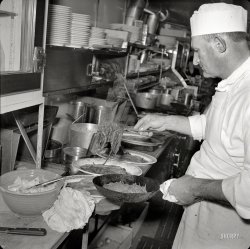
- Unemployment Lineup: 1939
- April 1939. "Salvation Army, San Francisco, California. Unemployed young men pause a moment to loiter and watch, ... are flared at the bottom. I know that was the style in San Francisco in 1967 but am surprised to see it in 1939. Were they Navy ... Posted by tterrace - 05/18/2015 - 9:47am -
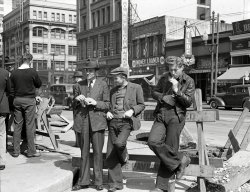
- Milady's Marmon: 1919
- San Francisco, 1919. "Marmon Limousine on Stockton Street at Union Square between ... The lady's muffled appearance suggests another balmy San Francisco day. I trust that the driver is wearing his long-johns under ... Posted by Dave - 05/08/2017 - 8:17pm -
